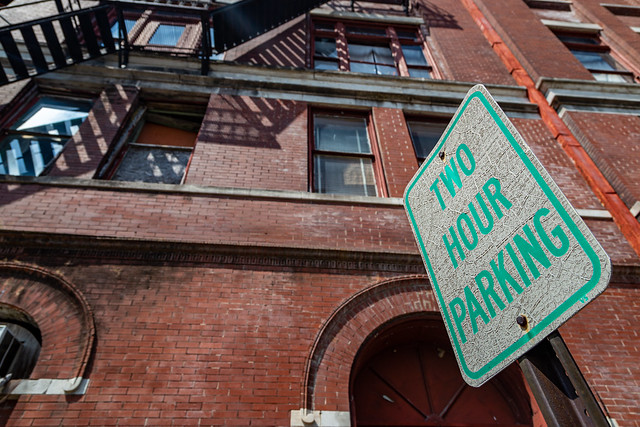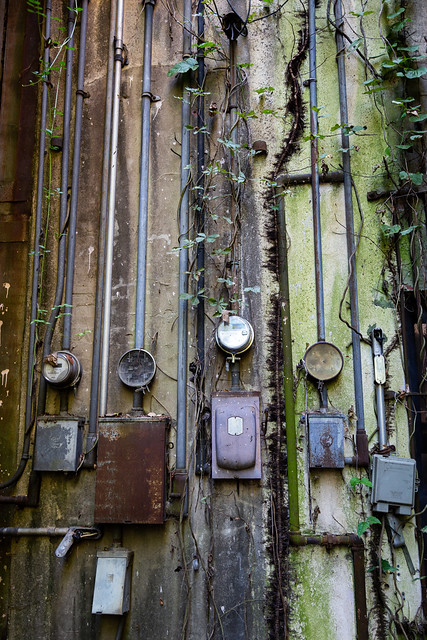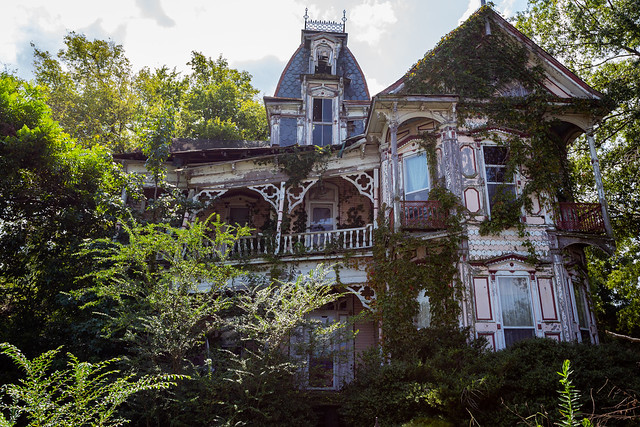Nearby is an old Greyhound bus station, which is also closed and empty. I looked but couldn't find a date when the building was built, but I did find that the station was the site of a refusal, by an African American war veteran in 1944, to go to the back of a segregated coach bus. The bus was preparing to go to Little Rock with the typical seating of the Jim Crow era, with whites in the front but Blacks in the back. The returning soldier, who was disabled, had taken a seat near the front. He was asked to move to the back of the bus when another white passenger got on the bus. When the solider did not respond, the white passenger uttered a racial slur and punched him. Several of the other Black passengers on the bus came to his defense, causing a confrontation. This was 11 years before Rosa Parks refused to give up her seat in Montgomery, and would be a preview of the upcoming confrontations of the Civil Rights movement.
By the train station is the old African American Masonic Temple, which was bult between 1902 and 1904. It was the tallest building in the city when it was built, and it still towers over the other buildings and nearby train traicks. Among the businesses housed here was the Unity Bank And Trust Company, which opened in 1902 and was Arkansas' first African American-owned bank.
The building is empty now, and was listed as one of Arkansas’ "Most Endangered Places" in 2015. But that designation also notes that the structure is in fairly good shape, all things considered, and that the owners hope to rennovate it into a mixed-use development. I hope the building can be saved, I would love to see what it looked like on the inside.
And along the sidewalk along the side of the bulding, where tall grass was growing through the cracks in the pavement.
Vines covered the back of a nearby older building, nearly shrouding this door from view.
And nearby were these old electrical meters, which were still since they were connected to buildings that were no longer occupied. A vine (which was maybe poison ivy?) snaked up between the boxes.
Pine Bluff has unfortunately developed a bad reputation, and has turned into one of the most unfairly maligned places in the state. And I, of course, realize that I am helping contribute to that here by posting pictures of abandoned and rickety old buildings. In my defense, these pictures were taken as part of an ongoing photography project that has meant to focus on abandoned and empty places. It is not my intention to only portray the city this way. There is a lot of activity here that is not always shown. There is a sparkling new aquatic center in Pine Bluff, and a brand-new fancy library that looks to be state-of-the art. On this visit, construction crews were building new sidewalks along Main Street. The city is not as dire as people in other parts of the state make it out to be.
There are lots of murals on the buildings downtown, showcasing various parts of the city's history. This one featured trains and the city's history with the railroad. A few vines were growing up onto the bricks.
Another photography project that I just started is to document the places connected to our state's sad history with lyching. That barbaric act has affected numerous cities across the state, including Pine Bluff. According to the Encyclopedia of Arkansas, a lynching in March of 1910 occurred near this spot right by the train tracks. Part of the description of the lynching is that it "was so quiet that when the news spread many persons could not give credence to it." One of the most shocking and terrifying things to read about these lynchings is how they were perpetrated by crowds who were described as quiet. To read more about the lynching of Judge Jones in 1910, please click HERE.
Another lynching occurred near one of the most prominent buildings in town - the Jefferson County Courthouse. The courthouse was built between 1856-1860, and is one of the oldest in the state. Unfortunately a fire destroyed most of the building in 1970, but the original facade was preserved and saved.
The lynching by the courthouse occurred in 1892. Again, according to the Encyclopedia of Arkansas: "The news spread around town, and a mob of 200 armed men met the train at 9:00 p.m.. Despite pleas from the mayor, the mob stopped the train and took the prisoner, marching him up the main street to the courthouse. By this time, the size of the mob had grown to around 1,000. While the crowd yelled, a rope was put around Kelley’s neck, and he was taken to the courthouse steps and given a chance to speak. He denied his guilt, saying that he had bought McAdams’s watch. The crowd then hanged him from a telephone pole that stood directly across from the courthouse. During this process, he allegedly confessed that he had hit McAdams but did not intend to kill him. After he was strung up, more than 100 bullets were fired at him." You can read more about it all HERE.
Just up the road from the courthouse, along a narrow alley is this old ghost sign for Coca-Cola. The ad promises that Coke "relieves fatigue," and as a parent of a fussy 7 week-old baby I can attest that the ad is true (we're living off of caffeine right now).
And one last picture form Pine Bluff, taken on the way home. This grand old Victorian home is covered in vines, with a downed tree covering the sidewalk. But a few dogs rushed out to bark at me while I took this, and a car was parked in the driveway (which makes me think people are still living there). But this such an amazing house I would be hesitant to give it up, no matter what shape it's in.



















No comments:
Post a Comment